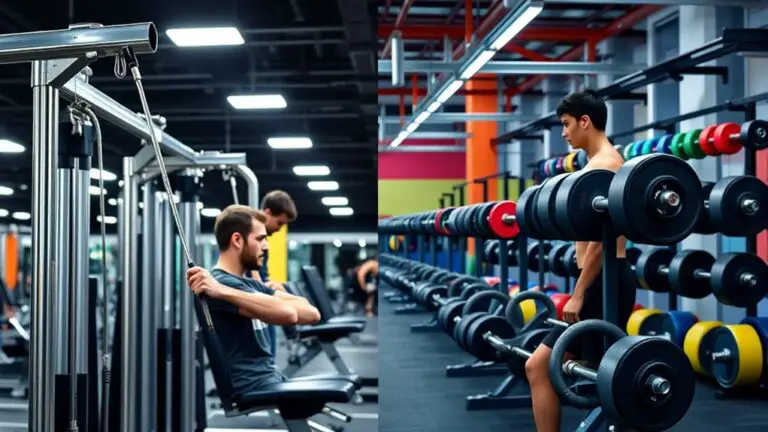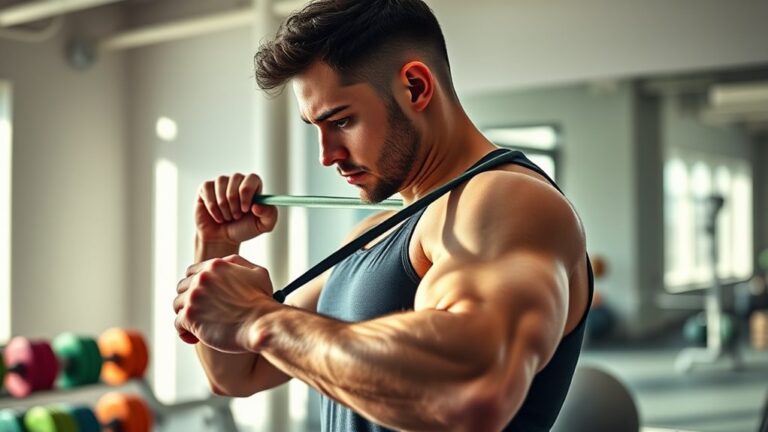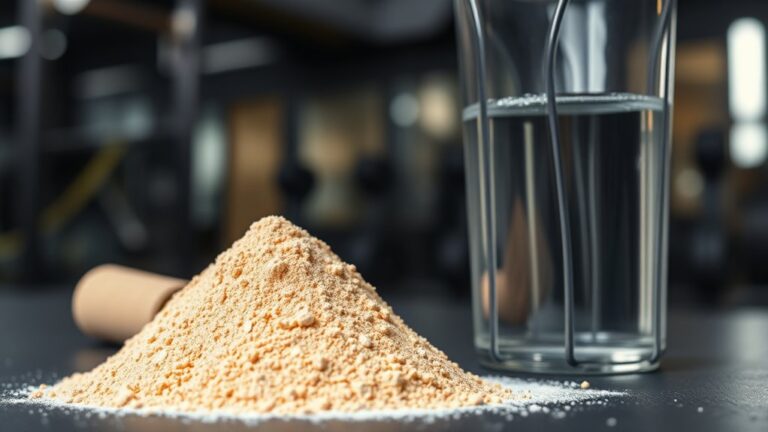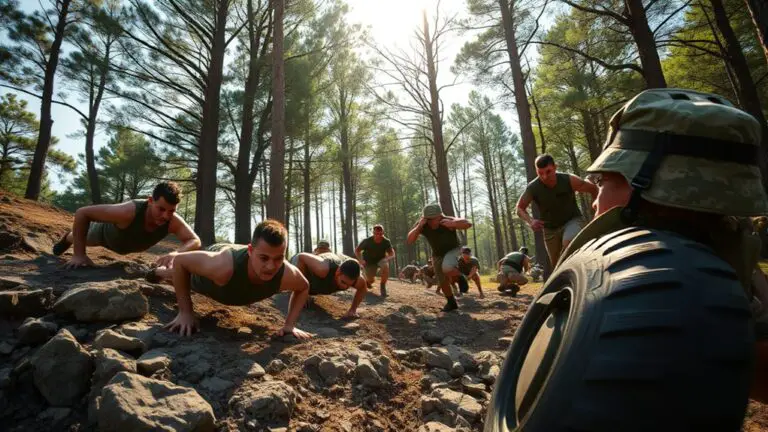How to Optimize Gym Workouts Using Biomechanics
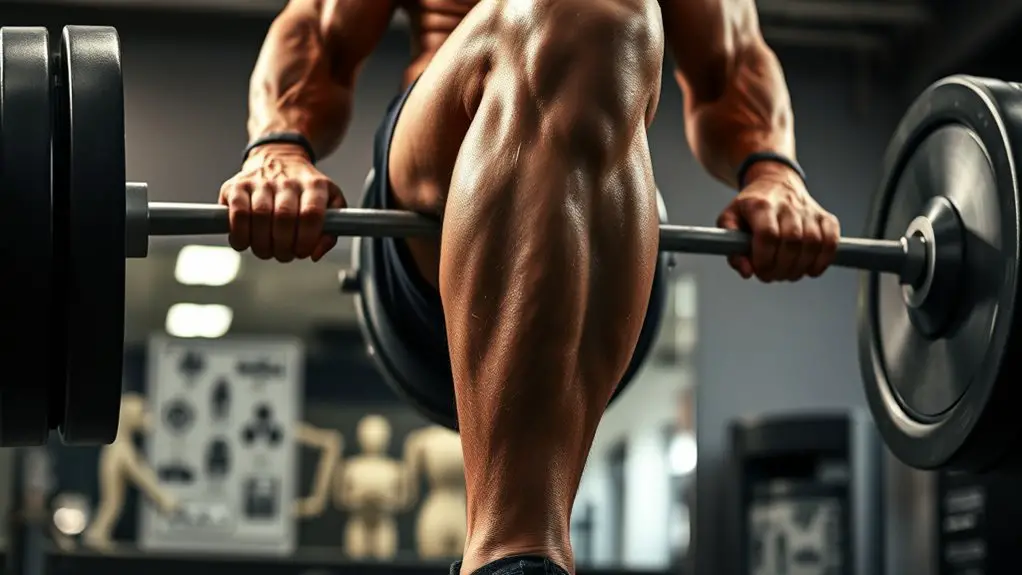
To optimize your gym workouts with biomechanics, evaluate your technique regularly using video analysis to spot form discrepancies. Focus on joint angle optimization and proper alignment to maximize muscle activation while minimizing stress and injury risks. Incorporate dynamic warm-ups and cool-down stretches to enhance performance and recovery. Additionally, use appropriate equipment, like resistance machines or free weights, to improve workout efficiency. By implementing these strategies, you’ll achieve sustainable progress. Discover further techniques for a thorough approach.
Understanding Biomechanics in Fitness
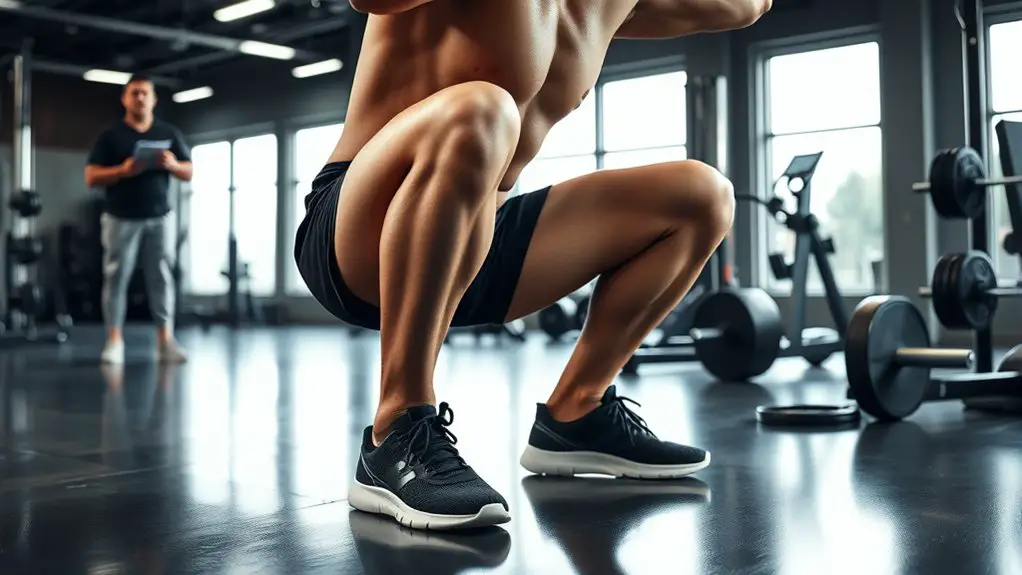
While you may be focused on lifting heavier weights or completing more reps, understanding biomechanics can greatly enhance your workout efficiency and reduce injury risk. By applying kinematic analysis, you can evaluate how your body moves during exercises. This analysis helps identify ideal joint angles and movement patterns, allowing you to maximize muscle activation while minimizing stress on joints and ligaments.
For instance, during a squat, proper alignment of the knees over the toes can prevent undue strain on the patellar tendon. Additionally, knowing how different muscle groups work together can inform your training. For example, activating the glutes effectively can improve stability and power during lifts. Implementing core strengthening exercises can also optimize your overall performance.
Incorporating biomechanical principles into your workouts not only enhances performance but also fosters a better understanding of your body’s mechanics, leading to safer and more productive training sessions.
Assessing Your Current Technique
Many gym-goers overlook the importance of regularly evaluating their technique, which can greatly impact their results and injury risk. Analyzing your current technique is critical for optimizing performance. Video analysis is an effective method for capturing your movements, allowing you to identify discrepancies in form. By reviewing your videos, you can spot common errors such as improper joint alignment or inadequate range of motion.
Once you’ve recorded your sessions, seek technique feedback from knowledgeable sources, such as trainers or experienced peers. This external perspective can highlight issues you might not notice on your own. Utilize tools like slow-motion playback to scrutinize your biomechanics in detail. Remember, even minor adjustments can lead to significant improvements in strength and efficiency. Regular evaluations not only enhance your lifting technique but also reduce the likelihood of injuries, ensuring you can train consistently and effectively. Consistent effort towards fitness goals indicates potential progress in your overall performance.
Key Biomechanical Principles for Common Exercises

Understanding key biomechanical principles is essential for optimizing your gym workouts. Force production mechanics, joint angle optimization, and movement pattern efficiency play significant roles in maximizing your performance and minimizing injury risk. By applying these principles, you can enhance your exercise effectiveness and achieve your fitness goals more efficiently.
Force Production Mechanics
Force production mechanics play a critical role in optimizing gym workouts, particularly when it comes to executing common exercises effectively. Understanding how to apply force and generate torque can enhance your performance and reduce injury risk. Here’s a quick reference table for key exercises:
| Exercise | Force Application | Torque Generation |
|---|---|---|
| Squat | Vertical force through heels | Hip and knee joint torque |
| Bench Press | Horizontal force from chest | Shoulder joint torque |
| Deadlift | Ground reaction force | Spinal and hip torque |
| Overhead Press | Vertical force through arms | Shoulder and core torque |
| Lunge | Forward force through front leg | Knee and hip joint torque |
Joint Angle Optimization
While optimizing joint angles during exercise is essential for maximizing performance and minimizing injury risk, it’s important to recognize how specific angles affect muscle activation and force production. Joint stability plays a critical role in maintaining effective movement patterns. For instance, during a squat, the ideal knee angle promotes quadriceps engagement while ensuring that the joints remain stable. Studies indicate that angle specificity can enhance muscle recruitment; consequently, performing exercises at varying joint angles can lead to improved strength and hypertrophy. Additionally, understanding the biomechanics of exercises like bench presses and deadlifts allows you to adjust angles to prevent injury. Ultimately, fine-tuning joint angles can greatly impact your performance and overall effectiveness in the gym.
Movement Pattern Efficiency
Effective movement patterns are fundamental for optimizing workout efficiency and enhancing overall performance in the gym. To achieve movement efficiency, you need to focus on technique refinement during common exercises. Analyzing biomechanics reveals that proper alignment and synchronized muscle activation can greatly reduce energy expenditure while maximizing force output. For instance, during a squat, ensuring your knees track in line with your toes can prevent unnecessary strain and improve stability. Similarly, in a bench press, maintaining a neutral wrist position enhances power transfer through the kinetic chain. By consistently monitoring and adjusting your form, you’ll not only increase your strength gains but also lower the risk of injury, leading to a more effective and sustainable workout regimen.
Incorporating Proper Warm-Up and Cool-Down Routines
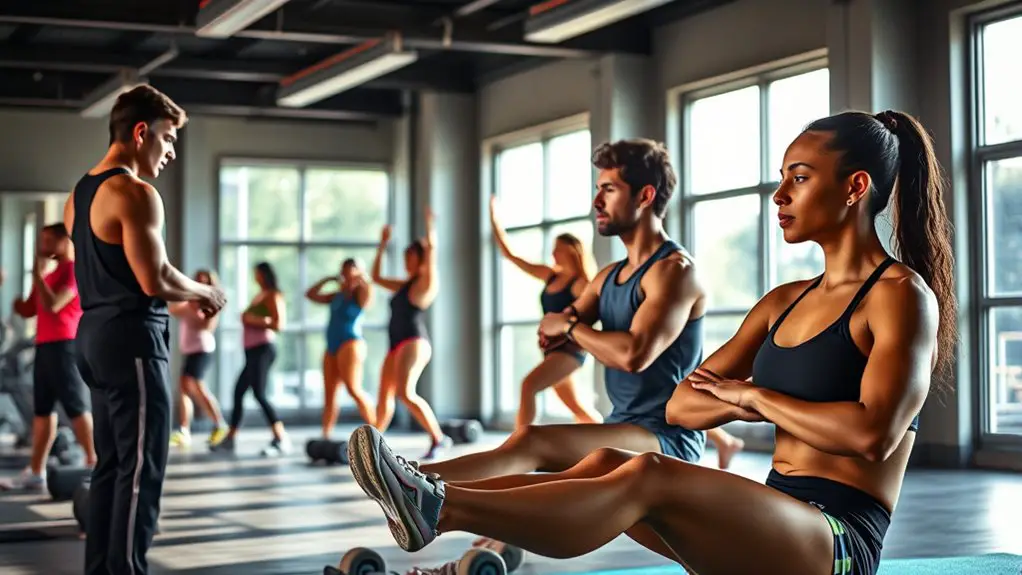
Incorporating a proper warm-up is essential for enhancing performance and reducing injury risk, as it prepares your muscles and joints for the demands of exercise. Research indicates that effective cool-down techniques can aid in recovery and minimize soreness by promoting blood circulation and reducing lactic acid buildup. By prioritizing these routines, you can optimize your overall gym experience and support long-term fitness goals.
Importance of Warm-Up
Since a proper warm-up greatly enhances performance and reduces the risk of injury, it’s essential to integrate this phase into your workout routine. Engaging in dynamic stretching prepares your muscles and joints for the physical demands ahead by increasing blood flow and improving elasticity. Research shows that dynamic stretching can enhance range of motion and reduce muscle stiffness, which is vital for peak performance. Incorporating mobility drills further complements your warm-up by improving joint function and stability, thereby enhancing your overall biomechanics. Specific exercises targeting key muscle groups will not only activate the nervous system but also prime the body for more strenuous activities. Prioritizing these components in your warm-up can lead to improved efficiency and effectiveness in your workouts.
Effective Cool-Down Techniques
A well-structured cool-down is just as important as a proper warm-up, as it aids in recovery and helps prevent post-workout complications. Implementing effective stretching techniques post-exercise can enhance muscle elasticity and reduce soreness. Focus on static stretches, holding each for at least 15-30 seconds, targeting major muscle groups worked during your session. This approach helps facilitate the removal of metabolic waste, promoting blood flow and nutrient delivery to fatigued muscles. Additionally, incorporating recovery strategies like deep breathing and foam rolling can further enhance relaxation and muscle recovery. By prioritizing these techniques, you not only optimize your body’s repair processes but also improve your overall performance for future workouts. Remember, a solid cool-down is essential for long-term fitness success.
Utilizing Equipment for Optimal Biomechanics
While many gym-goers focus primarily on the intensity of their workouts, utilizing equipment effectively can greatly enhance biomechanics and overall performance. Proper equipment selection is vital; choosing machines or free weights that match your body dimensions helps create a more effective and safe training environment. For instance, selecting a bench press that allows your elbows to remain aligned with your wrists optimizes force transfer and minimizes injury risk.
Additionally, making ergonomic adjustments is essential for optimizing your biomechanics. Adjusting seat heights, backrest angles, and grip widths can markedly impact your range of motion and muscle activation. Research indicates that even minor adjustments can lead to increased strength gains and reduced stress on joints. By prioritizing these factors, you not only improve your performance but also promote long-term health, ensuring that your workout regimen is both efficient and sustainable. Incorporating exercises like the single-arm dumbbell overhead press can also help address muscle imbalances and improve shoulder stability.
Tracking Progress and Making Adjustments
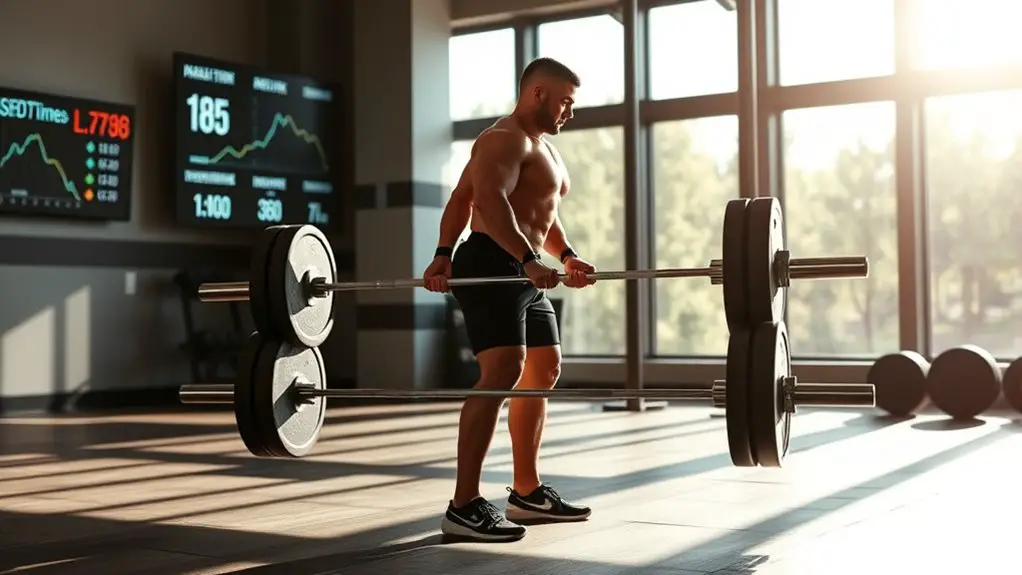
To maximize your workout effectiveness, tracking progress and making informed adjustments is vital. By using specific progress metrics, you can objectively evaluate your performance and identify areas needing improvement. This data-driven approach allows you to apply effective adjustment strategies tailored to your unique biomechanics. Additionally, understanding your daily caloric intake is crucial for fueling your workouts and recovery.
| Metric | Measurement | Adjustment Strategy |
|---|---|---|
| Weight Lifted | Total pounds lifted | Increase by 5% weekly |
| Reps Completed | Total reps per set | Add 1 rep each session |
| Exercise Duration | Time in minutes | Extend by 2 minutes weekly |
| Heart Rate | BPM during workouts | Decrease intensity if >85% |
| Form Assessment | Video analysis | Modify technique as needed |
Regular reassessment using these metrics guarantees your workouts align with your goals, optimizing both performance and safety. Remember, informed adjustments can lead to sustainable progress.
Frequently Asked Questions
How Can I Prevent Injuries During Workouts Using Biomechanics?
Think of your body as a finely tuned machine; every part needs to work in harmony. To prevent injuries during workouts, focus on movement analysis. Assess your biomechanics to identify improper techniques that could lead to stress on joints and muscles. Make adjustments to your form, ensuring alignment and balance. Incorporate strength training and flexibility exercises tailored to your specific needs, which can greatly enhance injury prevention and improve overall performance.
What Role Does Flexibility Play in Biomechanics and Workouts?
Flexibility plays an essential role in biomechanics and workouts, impacting your overall performance. Improved flexibility benefits your range of motion, allowing for more efficient movement patterns. This enhancement can lead to better force production and reduced risk of injury. Evidence suggests that incorporating flexibility training into your routine not only aids in range improvement but also promotes muscular balance, vital for ideal biomechanics during various physical activities. Prioritizing flexibility can greatly elevate your workout effectiveness.
Can Biomechanics Help With Weight Loss Goals?
Imagine your body as a finely tuned machine, each movement precise and purposeful. By understanding biomechanics, you can maximize your weight loss efforts. Biomechanics benefits include improved movement efficiency and reduced injury risk, allowing you to push harder during workouts. Analyzing your form helps identify weaknesses, leading to targeted exercises that burn more calories. With a strategic approach, you’ll not only shed pounds but also enhance overall performance and strength.
Is There a Difference Between Biomechanics for Strength Training and Cardio?
Yes, there’s a significant difference between biomechanics for strength training and cardio. In strength training, biomechanics focuses on optimizing force production, joint angles, and muscle engagement to maximize power and minimize injury risk. Conversely, in cardio, it emphasizes efficient movement patterns, energy expenditure, and aerobic capacity. Understanding these cardio differences allows you to tailor your workouts effectively, ensuring you’re not only improving performance but also enhancing your overall fitness and health outcomes.
How Often Should I Reassess My Technique for Optimal Biomechanics?
You should reassess your technique regularly, ideally every four to six weeks, to guarantee ideal biomechanics. This technique evaluation helps identify any inefficiencies or risks of injury, ultimately leading to performance improvement. As you progress, your body adapts, which may alter your form. Utilizing video analysis or feedback from a coach can provide valuable insights, allowing you to make necessary adjustments and maximize your workout effectiveness while minimizing potential injuries.
